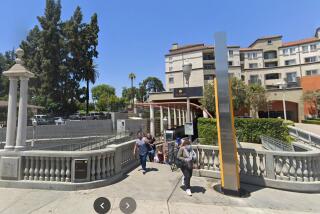Despite Its Risk, Railroad Shortcut Is Well-Worn : Safety: Death of two women may lead to construction of a fence to block path regularly used by commuters in Del Mar.
- Share via
Cabdriver Eric McMullan called it “an accident waiting to happen.”
For weeks, he has watched commuters parking their cars in the lot next to the Del Mar train depot and wondered if and when a tragedy might occur.
“I’m not in the least surprised . . . that someone died,” he said Wednesday at sunset, as commuters by the dozen, oblivious to the blood stains under their feet, crossed from the Seagrove Parking lot to the red-brick depot across the tracks.
About 11 hours earlier Wednesday, at about 6:35 a.m., a clothing designer named Usha Waney died as she attempted to cross the tracks while running from the lot to the depot. Witnesses said Waney had fallen and was semi-conscious after striking her head on one of the steel rails.
Her would-be rescuer, Roberta Halpern, a researcher at the Regional Cancer Center in La Jolla, was fatally injured while trying to pull Waney from the tracks.
Waney apparently thought the northbound freight train she heard coming was the passenger train she needed to catch.
“Maybe the parking lot was a good idea for the sake of convenience,” said McMullan, who moved to San Diego County from Ireland several years ago. “But people cross there every day--look at them, crossing now, like it never happened--and she isn’t the first to trip and fall. She had to go across gravel, ties and steel, and, after she fell, she didn’t have much of a chance, now did she?”
John King, owner of Seagrove Parking, said the lot was opened in the summer of 1987 but that, before then, commuters parked in a dirt lot and made the risky trek across the narrow, choppy pathway, preferring not to walk south to the point where the rails and the street are a smooth, flat surface.
King said that, beginning this morning, he intends to push forward with building a fence so that commuters will be forced to cross about 25 yards south, at the point where Coast Boulevard and the rails make the walking easier. But, even at that point, he said, there is no train-crossing signal to act as a barrier.
“I’m going to stop the problem before it happens again,” King said. “I’ll put in a fence to block the pathway, so that people aren’t jumping the tracks and tripping.”
King said part of the blame for the tragedy lies with commuters, “who should know that you don’t just cross a track when a train is coming.”
Businessman Dennis Hearst was waiting for the 5:24 p.m. train from San Diego to Los Angeles on Wednesday with a group of colleagues who had heard about the tragedy while on a southbound train from L.A.
“Part of the problem is, we’re so car-conscious in the United States,” Hearst said. “Few people would think about dashing across a freeway. And, in Europe, where people are much more train-conscious, few would think about dashing across train tracks, especially after they’d just heard one coming.”
“This looks very dangerous here,” said Los Angeles businessman John Cushman, pointing to the spot where Waney died and where Lee Kaiser and Halpern, his wife, tried to help her. Kaiser was also injured. “The poor woman must have been rushing for the train, thinking it was her train, and she just . . . fell. It looks very rough there”--he pointed to the uneven pathway of gravel, rail and thick wooden ties--”and I’m amazed it hasn’t happened more often.”
Steven Campbell, an Amtrak ticket taker working the window at Del Mar on Wednesday evening, said a bicyclist was struck two years ago at the point where the tracks meet Coast Boulevard and said he has heard of several close calls at the spot where Waney was killed.
“The trains just come barreling around the bend, with their lights on and the whistle blowing, and, even though they give fair warning, they’re often rumbling much faster than anyone thinks they are,” Campbell said. “And the freights, which don’t stop here, are usually going faster than the other ones.”
Campbell said the station had been a beehive of conversation and activity all day Wednesday, with people speculating as to what really happened and why and how it might have been prevented. He said some of the same people who said that crossing the pathway from the parking lot to the depot was a terrible idea were doing it themselves a few minutes later.
Late Wednesday, on the wall of the depot, someone had posted a notice, informing anyone who witnessed the tragedy that a “debriefing” was scheduled for 10 a.m. Saturday at the Inn L’Auberge in Del Mar, a few steps away.
The session’s sponsor: the Trauma Intervention Program of North County.
“The thing that angers me,” said businessman Hearst, “is that everyone acknowledges how risky this pathway is, and how stupid it is to cross it, and yet, where are the warning signs? Do you see any guards? A fence? It looks like someone could have made more of an effort somewhere. And now that an effort may be made, it took someone’s death to force it.”
More to Read
Sign up for Essential California
The most important California stories and recommendations in your inbox every morning.
You may occasionally receive promotional content from the Los Angeles Times.













